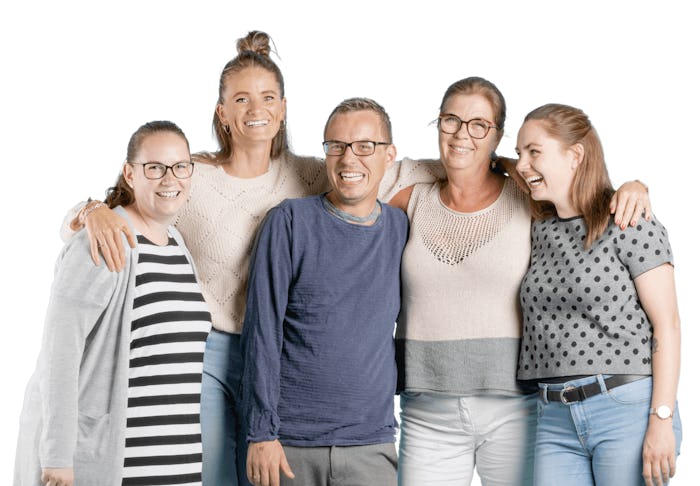Get ready to be blown away by JoJo Knitwear. Danish designer Ane Kofod, the talent behind the brand, is not just a skilled knitwear designer; she also has a unique ability to capture the essence of nature’s beauty and transform it into elegant and eye-catching designs. Meet her here!

Are you a fan of Nordic style and beautiful designs that are rich in detail yet simple and elegant? Then we can confidently say you’ll love JoJo Knitwear!
In this interview, you'll get to know Ane Kofod, the creative mind behind JoJo Knitwear. Raised near the roaring North Sea along Denmark's west coast, it’s no secret that this is where she draws her inspiration and unique design DNA. 🌊🌾🐚 Ane has also spent 10 years designing and sewing dresses for the hosts of the Danish version of 'Dancing with the Stars' and has been involved in theater and film productions in the U.S.! 👏💃🎬
In collaboration with Hobbii, Ane has just released the Natural Beauty collection, featuring six incredibly beautiful knitting patterns. 😍 It's hard not to be inspired by Ane's creative mind and passion for the art of knitting!
Here, you can learn much more about her – from her favorite places to knit to how she finds inspiration and brings her ideas to life.
1. What’s your favorite place to knit?
“I love knitting absolutely anywhere, at any time. In my opinion, most situations only get better when you have your knitting project with you. It instantly gives me a sense of calm and well-being, even when there’s chaos around me.
In my living room, I have a knitting corner with the perfect chair, baskets of yarn on the floor, and a good lamp. I sit there and knit almost every evening. In the summer, I love sitting on my terrace in the shade of my fig tree, knitting to the sound of birdsong above and with my cat sleeping beside me.”
2. Where do you find inspiration for new knitting patterns?
“Finding inspiration for new designs is a process for me that involves both structure and spontaneity. I’m often in a creative mode in my mind, always circling around new knitting ideas, textures, and silhouettes I want to explore. I constantly observe the world around me through 'knitting eyes.' I look at and study every piece of knitting and technique I come across. I’m always taking pictures along the way and jotting down notes on my phone to remember my thoughts.
I also love exploring old techniques and textures, then placing them in a new context. It could be textured knitting from the 1950s, browsing through old knitting books, or studying Norwegian patterns, which I reinterpret into something different and integrate into a fresh setting.”
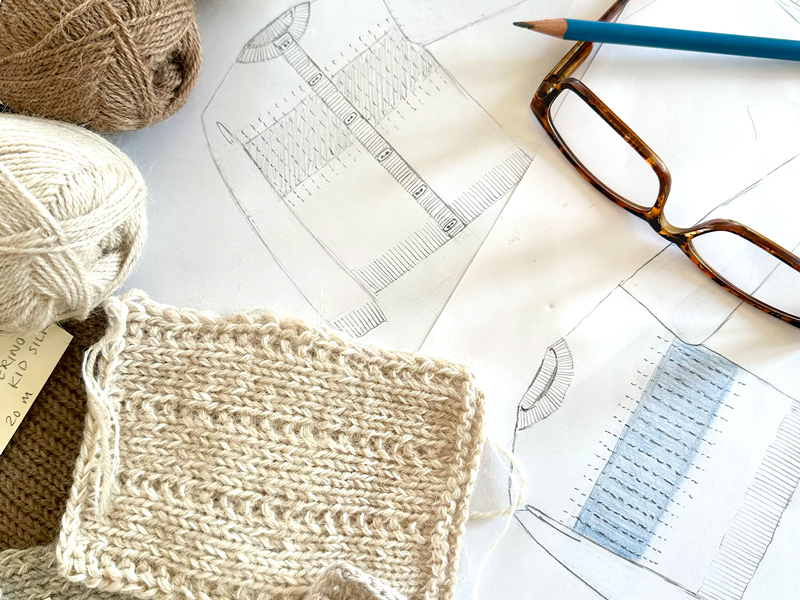
3. What does your design process look like from idea to finished design?
“My head fills with ideas, and then I start making swatches with all kinds of yarns to see if the idea I envision actually works in reality. I pick details, techniques, and yarn choices and combine them in a way that inspires me.
One swatch often leads to another, and suddenly the idea evolves in a completely new direction. Sometimes, an entirely new idea emerges during the process—one I had never thought of before. It’s a fantastic feeling when something comes out of the blue and takes shape in your hands. So, experimenting without too many fixed plans can sometimes lead to surprises and new designs.
Once I have a pattern or texture in place, I design the fit for the model. Then I start calculating the different sizes. I begin knitting the first model and try it on as I go to make adjustments if it’s not developing as expected.
When the first model is finished, it’s the test knitter’s turn. All sizes are tested. This way, I can see if my pattern is clear and easy to understand. At the same time, the test knitter provides feedback on the fit. I’m always open to suggestions and ideas from my testers because my goal is to ensure happy knitters who will love their finished product.”
4. What makes a design unique?
“A good design should fulfill its purpose and meet the needs of the user while being harmonious and aesthetically pleasing. Great designs are innovative and stand out from the crowd with their own unique DNA. They bring something new or distinctive to the table, whether through their form, function, or materials. The design should feel intuitive and be visually appealing.
I always consider the balance in the amount of detail because I often get carried away with excitement. With that in mind, I sometimes need to adjust the richness of details in my sweaters. At the same time, the design should definitely stand out from the crowd and have a wow factor and something original.
Since I’m a trained tailor, I also prioritize a good fit, and with my knowledge of pattern construction, I try to incorporate that good fit into my knitting patterns.
There is certainly also value in the emotional aspect. A good design can have the ability to create an emotional connection with the user. I’ve experienced this myself, in all areas—whether it’s interior design, clothing, art, or architecture—when a design communicates or symbolizes something you value. It can evoke a feeling or a memory inside you and bring excitement and joy. And that’s why you feel drawn to it, giving the object a deeper value. It would be amazing if I could pass that feeling on to others through my designs. Ultimately, it’s all about spreading joy.”
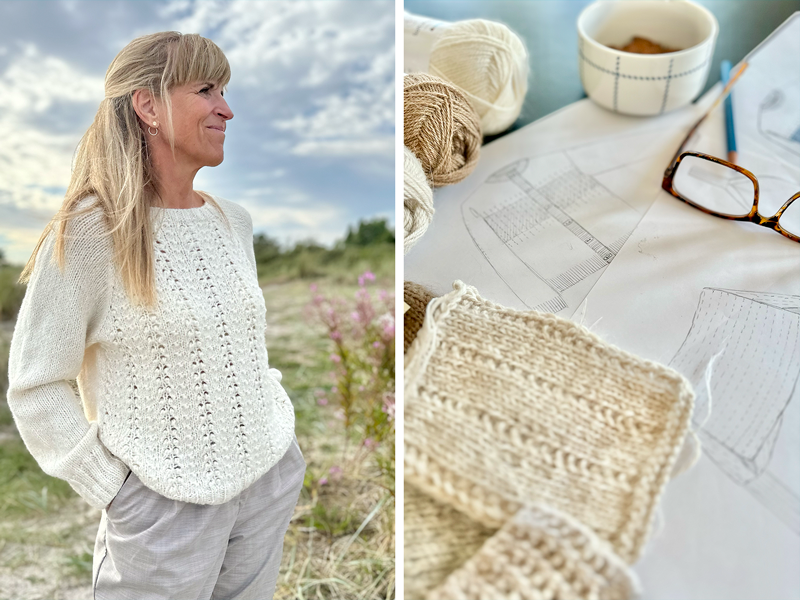
5. How do you work with materials and colors?
“First and foremost, it’s essential that the product I’m trying to create aligns with the choice of materials and colors. By this, I mean that it’s important to find the right yarn for the chosen technique, for example. The technique needs to be highlighted in the right way. Some yarns will cause the details to become diluted and disappear. So, for me, knitting swatches is very important to test and refine the choice of materials. I often use a companion thread to create different textures. Personally, I have a fondness for wool—all kinds and varieties.
When it comes to colors, it’s crucial to understand a bit of color theory and color psychology to achieve balance and contrast in an exciting way. Again, it’s often the case that more detail can be seen in lighter colors, whereas details can get lost in darker colors. So, I often choose lighter colors so that the knitter can see the design more clearly. But I love working with colors. I enjoy seeing on Instagram when people post their own color choices; it’s incredibly inspiring to see how people personalize the design and make it their own.
With a good understanding of color and a creative approach to materials, you can create designs that are both beautiful, functional, and personal.”
6. What were your thoughts behind the Natural Beauty collection?
“I started by creating a mood board that summarized what Natural Beauty means to me. I grew up in North Jutland, Denmark, near the North Sea, and I thought about the nature I grew up in—fields of grain, the sea, and the wind. At the same time, I felt that my mood board created a beautiful color palette that I could use. When I later looked at the images, I was inspired by the texture of the grain fields and the way the stalks sway in the breeze at the beach. This became the inspiration for the textures I created in the Barley Field and Meadow Sunset series.
The Barley Field series features a textured pattern on the front, which refers to a field where the grain moves in gentle waves in the wind. It can almost create a visual effect, making it look as if the field is rippling like the sea. This is not just a beautiful sight, but also a powerful natural metaphor symbolizing abundance and fertility. I fell in love with the combination of Divina and Soft Alpaca Lace. It’s such a soft yarn combination, and it beautifully highlights the lace pattern. I always strive to create a sweater that’s both enjoyable to knit and that you’ll love to wear again and again, and I think this yarn combination is perfect for that.”
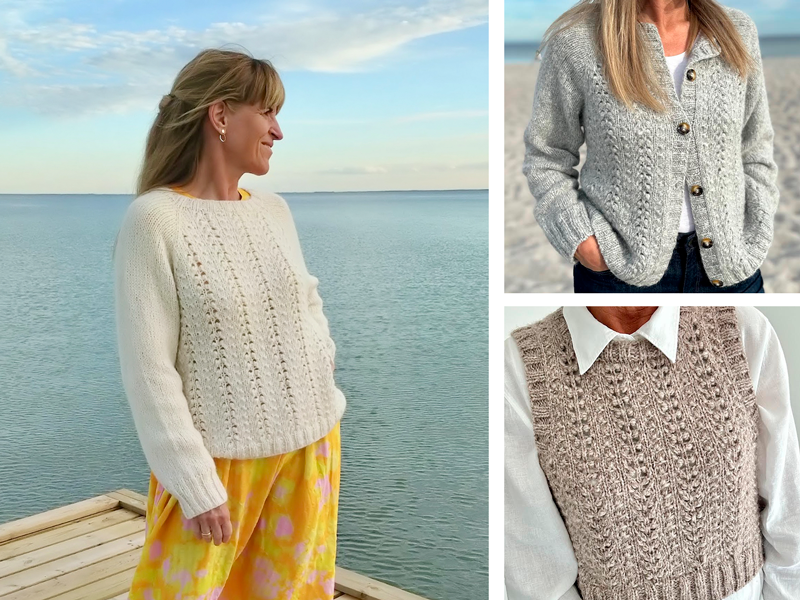
Discover the Barley Field series here: 1) Barley Field – Cardigan 2) Barley Field – Sweater 3) Barley Field – Slipover.
“The Meadow Sunset series features a horizontal colored stripe on the sweater, symbolizing a sunset on the horizon. The texture within the colored stripe represents the stalks standing on the beach. Though they are fine and delicate, their roots are firmly planted in the ground, standing untouched despite the wind and weather. It’s a bit like us humans, each of us facing challenges. While the sunset marks an ending, it also heralds a new beginning when the sun rises again the next morning. The choice of two strands of Soft Alpaca was once again aimed at creating a sweater that is soft and wonderful to wear. The yarn produces a beautiful stitch pattern, and the color palette is very inspiring.”
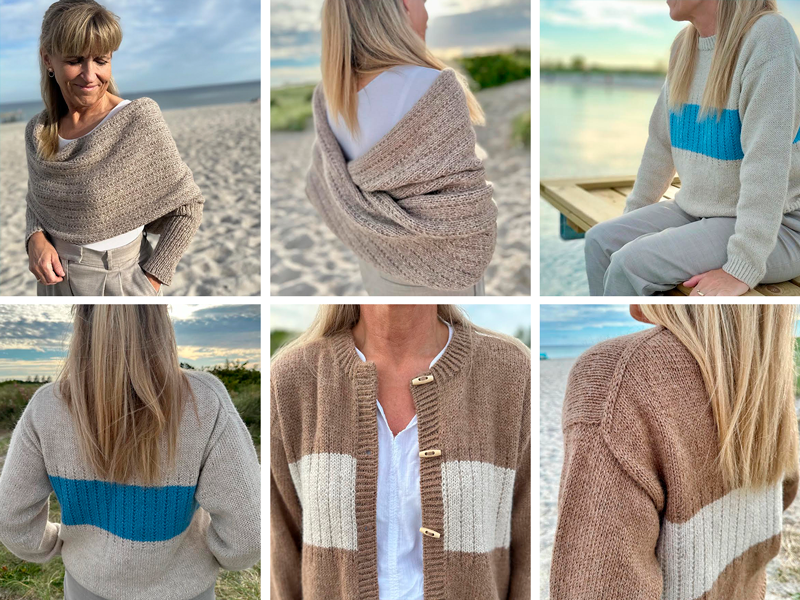
Discover the Meadow Sunset series here: 1) Meadow Sunset – Cardigan 2) Meadow Sunset – Sweater 3) Meadow Sunset – Wrap.
“I think my personal favorite is the Barley Field series. I love a knitting project with details; it makes it interesting to knit. This design truly embodies my DNA as a designer. You can see that if you look at my designs over time. Plus, Divina and Soft Alpaca Lace are such wonderful yarns to both knit with and wear. The cardigan has already become a favorite in my own wardrobe.”
7. What are your 3 best tips for new knitters?
“1 – Choose a project you’re confident you can complete and that you’re excited to start. Personally, I don’t think you should begin with a dishcloth if that sounds boring to you. You should start with something you’re passionate about and eager to make.
2 – Pick a project on 5 mm needles or even thicker. Smaller needles are harder to work with and take longer. Personally, I love being able to see the knitting grow quickly and feel the progress.
3 – Team up with a good knitting friend. Someone who can help you when you need it. Most knitters love to help.
Two little fun things I like to say: First, knitting is about the process, not the finished result. And second, a true knitter rips out stitches every day.”
Get the patterns here
Have you also fallen head over heels for Ane’s beautiful patterns? Now it's just a matter of choosing your favorite and getting started! Are you more drawn to the Barley Field series or the Meadow Sunset patterns?
